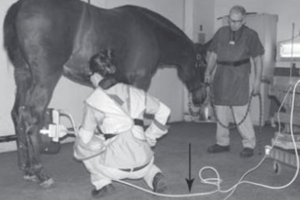Podcast
Questions and Answers
What is an enema?
What is an enema?
- A type of X-ray used to diagnose disease
- A type of radiation therapy
- A liquid introduced into the bowel through the anus (correct)
- A medical instrument used for surgery
What are repeated X-rays used to measure?
What are repeated X-rays used to measure?
- The patient's height
- The patient's weight
- The effectiveness of treatment
- The progress of a disease (correct)
What happens to an X-ray image if a patient moves during the procedure?
What happens to an X-ray image if a patient moves during the procedure?
- The image disappears
- The image becomes blurred (correct)
- The image becomes clearer
- The image remains the same
When is it easier to see abnormalities in the lungs?
When is it easier to see abnormalities in the lungs?
What is the term for a technician who administers X-rays?
What is the term for a technician who administers X-rays?
What is the term for something that is not penetrable by radiation?
What is the term for something that is not penetrable by radiation?
What is the term for using radiation to diagnose and treat disease?
What is the term for using radiation to diagnose and treat disease?
What is the term for something that is penetrable by radiation?
What is the term for something that is penetrable by radiation?
What is the term for the process of breathing?
What is the term for the process of breathing?
What is the term for a medical action intended to improve a patient's condition?
What is the term for a medical action intended to improve a patient's condition?
Flashcards are hidden until you start studying
Study Notes
Radiography and Radiology
- Radiography involves exposing a part of the body to a small dose of radiation to produce an image of internal organs.
- Organs with high density, such as ribs and spine, are radiopaque, meaning they don't absorb radiation, and appear white or light grey on the image.
- Lung tissue is radiolucent, absorbs radiation, and appears dark on the image.
- Contrast medium, such as barium or iodine, is used to examine organs or tissue it fills.
- Radiology is the use of radiation in the diagnosis and treatment of diseases, such as cancer.
X-ray Examination
- Chest X-ray is the commonest diagnostic X-ray examination.
- A frontal (anteroposterior) view is obtained with the patient standing facing the photographic plate.
- The patient is asked to breathe in deeply and not to breathe out to prevent a blurred image.
- A side, or lateral view, is obtained with the patient standing sideways to the photographic plate with arms raised.
- Chest X-rays may be repeated at intervals to track changes, known as serial chest X-rays.
Computed Tomography (CT)
- CT uses an X-ray source that rotates around the body to produce cross-sectional images.
- The new scanner takes up to 16 simultaneous cross-sectional images (slices) and transmits more data in less time.
- Each slice can be less than one millimeter thick, making it possible to find very small abnormalities.
- CT scanner is used for diagnosing muscle and bone disorders, locating tumors, infections, and clots, monitoring the progress of malignant diseases, and providing accurate guidance for interventional procedures.
Studying That Suits You
Use AI to generate personalized quizzes and flashcards to suit your learning preferences.




